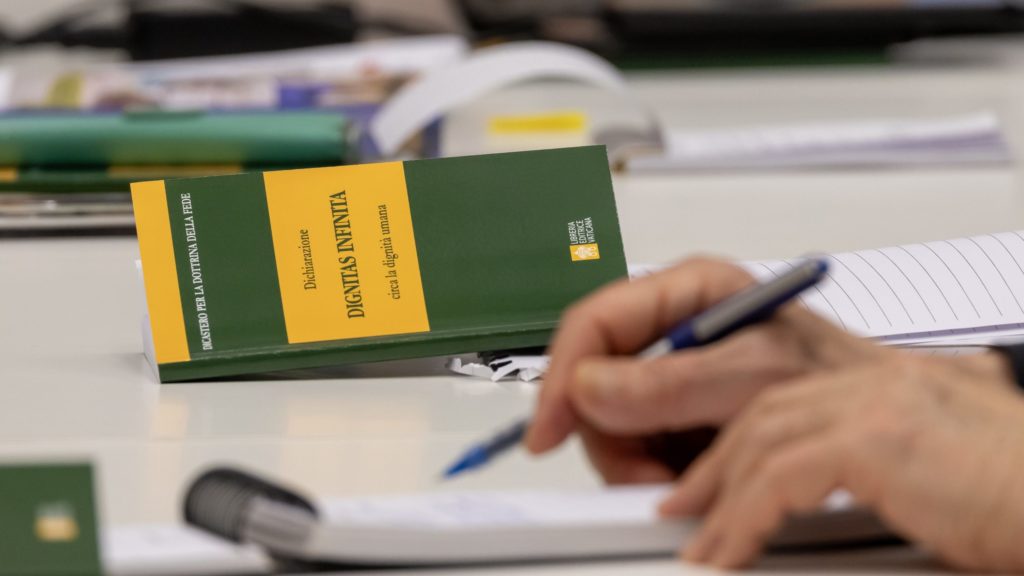ROME — Perhaps it’s a measure of the almost surreal media narrative that’s grown up around Pope Francis for the last 11 years that the Vatican could issue a document April 8 opposing abortion, euthanasia, surrogate motherhood, gender theory, and sex-change procedures, and it would somehow be considered news.
From a media point of view, Dignitas Infinita (“Infinite Dignity”), the latest declaration from the Vatican’s Dicastery for the Doctrine of the Faith, should have been a “dog bites man” exercise. Only in the Francis era, when we’ve been conditioned to expect doctrinal revolutions at every turn by previous documents such as Amoris Laetitia (“The Joy of Love”) in 2016 and Fiducia Supplicans (“Supplicating Trust”) last December, could “Pope upholds Catholic teaching” actually become a headline.
Unfortunately, the clamor over the content of Dignitas Infinita, and what precisely to make of its various formulae, risks missing the real point. Unlike its predecessors mentioned above, Dignitas Infinita was not conceived as a statement about Catholic teaching, even if it was issued by the doctrinal office.
Instead, Dignitas Infinita amounts to a direct frontal challenge to Catholic sociology, in particular the marked tendency for pro-life and peace-and-justice Catholics to inhabit different worlds and, quite often, to end up working at cross-purposes.
This point was driven home in an article for Vatican News written by Andrea Tornielli, the veteran Italian journalist who now serves as the pope’s editorial director, and arguably his most important official interpreter. To put an exclamation point on things, Tornielli’s editorial was distributed by the Vatican Press Office to the media at the same time as advance copies of the document itself, as if to lend his analysis official standing.
“The principal novelty of the document, which is the fruit of five years’ work, is the inclusion of certain important themes of the recent papal magisterium alongside bioethical matters,” Tornielli wrote.
“In the non-exhaustive list that’s offered of violations of human dignity, abortion, euthanasia, and surrogate motherhood are accompanied by war, the drama of poverty and of migrants, and human trafficking,” he said.
Then, Tornielli arrives at the bottom line.
“The new text thus contributes to overcoming the existing dichotomy between those who concentrate in an exclusive way on the defense of unborn life, or the dying, forgetting many other offenses against human dignity, and vice-versa, those who concentrate only on the defense of the poor and of migrants, forgetting that life must be defended from conception to its natural end,” he wrote.
Anyone familiar with the sociology of the Catholic Church, perhaps especially in the United States but also in many other parts of the world, and who’s being honest about it, would have to acknowledge that Tornielli isn’t just spitting in the wind.
Of course, there are plenty of exceptions, but as a general rule, self-described pro-life Catholics and peace-and-justice Catholics simply do not work and play well together. What’s worse, much of the time they don’t even know one another, except by reputation and social media profiles (which, in the 21st century, usually amount to the same thing.)
Pro-life Catholics follow their own heroes, read their own media outlets, attend their own conferences and meetings, and organize their own activities, often moving in their own self-contained and hermetically sealed universe.
Much the same can be said, pari passu (at an equal pace), of their counterparts in the peace-and-justice galaxy of Catholicism.
Church activists engaged in the fight against the death penalty, for example, or for immigration reform, or for poverty relief overseas, or anti-racism campaigns, or any number of other good causes fully endorsed by Catholic social teaching, likewise consume their own media sources, have their own revered points of reference, attend their own rallies and summits, and often have little to do with Catholics of other persuasions.
To put the point differently, and again with allowances for notable exceptions, the overlap in Catholic attendance at, say, the March for Life and the various George Floyd protests, is likely fairly small.
I’ve been using American examples, but the same observation could be made about Catholicism elsewhere, most particularly across the Western world where the battle lines between left and right have become hardened.
Here in Italy, for instance, there’s relatively little cross-over between Catholics involved in, say, the Community of Sant’Egidio, a center-left movement especially engaged in ecumenical and interfaith dialogue, conflict resolution, and poverty relief, and the Family Day Association, a group founded by Massimo Gandolfini, a neurosurgeon and member of the Neocatechumenal Way, which is devoted to opposition to gender theory, abortion, and other measures considered anti-family.
Against that backdrop, Dignitas Infinita isn’t about revising Catholic social teaching. It’s about challenging the way that teaching is often sliced and diced in the way it’s applied on the basis of personal preference, ideological affinity, and the raw fact of who somebody’s friends may be.
The message of the new document is that Catholic social teaching is a full-course meal, not a do-it-yourself buffet.
A former papal ambassador to the United States, Italian Archbishop Pietro Sambi, used to roll out a one-liner anytime the issue of abortion came up in conversation with American Catholics, which, as you might imagine, it did a lot during his tenure from 2005 to 2011.
“To be Catholic, you must be pro-life,” Sambi would always say. “But to be Catholic, it’s not enough to be pro-life,” using the term in its American sense of “anti-abortion.”
Sambi could have been the godfather of Dignitas Infinita, because that’s its message too. Now, the question becomes how well that message will be received and applied, a point arguably of special interest in America ahead of the 2024 elections.

